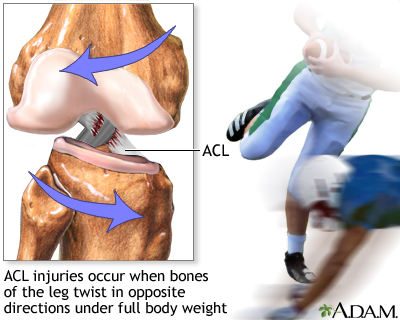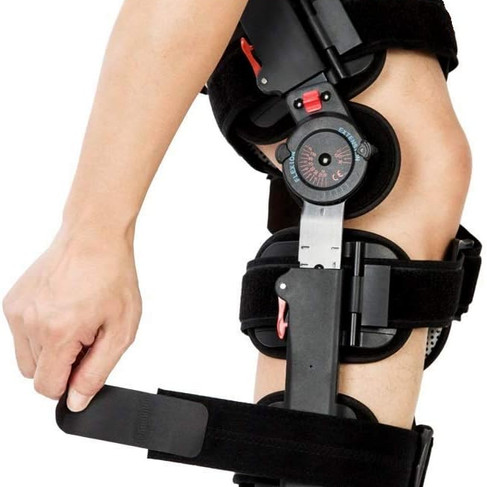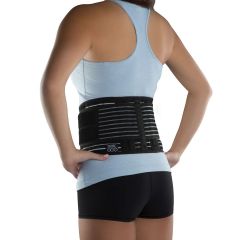
Sport braces are extremely popular among athletes, fitness enthusiasts, and active Individuals of all levels. Whether it's a knee brace, ankle brace, or back brace, these supportive devices claim to reduce the risk of injury and enhance athletic performance. But are sport braces worth the hype? Let's weigh the pros and cons.
On one hand, sport braces provide extra stability and support to vulnerable joints, reducing the chances of sprains, strains, and other common sports injuries. They help athletes recover from injuries and continue participating in their favorite events. Additionally, sport braces can improve proprioception, the body's ability to sense its position in space, which can lead to better balance and coordination.
However, some argue that sport braces may actually weaken the muscles and ligaments over time, as the body becomes reliant on the external support. There is also the risk of improper fitting or misuse, which can exacerbate existing injuries or create new ones.
In this article, we will explore the pros and cons of sport braces in greater detail, helping you make an informed decision about whether they are a necessary addition to your athletic gear. So, lace up your shoes and let's dive in!
Benefits of Using Sport Braces

Sport braces offer several benefits to athletes and active individuals, making them a valuable addition to their gear. One of the primary advantages is the extra stability and support they provide to vulnerable joints. For example, knee braces can help prevent ACL tears and other knee injuries by limiting excessive movement and absorbing impact. Similarly, ankle braces can provide stability and prevent ankle sprains, which are common in sports like basketball and tennis. By reducing the chances of sprains, strains, and other common sports injuries, sport braces allow athletes to perform at their best and minimize time spent on the sidelines.
Furthermore, sport braces aid in the recovery process for athletes who have suffered injuries. They can help maintain proper alignment and protect the injured area, allowing athletes to continue participating in their sport of choice during the healing process. By providing support and reducing strain on injured muscles and ligaments, sport braces can expedite recovery and prevent further damage.

In addition to injury prevention and recovery, sport braces can improve proprioception, which refers to the body's ability to sense its position in space. By providing a tactile feedback mechanism, braces enhance proprioception, leading to better balance and coordination. This can be particularly beneficial for athletes involved in sports that require precise movements, such as gymnastics or martial arts.
While sport braces offer numerous benefits, it is essential to consider the potential drawbacks before incorporating them into your athletic routine.
Common Types of Sport Braces
Sport braces come in various forms, each designed to address specific areas of the body. Understanding the different types can help you choose the most suitable brace for your needs.

1. Knee Braces: Knee braces are among the most commonly used sport braces. They come in different styles, including sleeves, wraps, and hinged braces. Sleeves provide compression and support, while hinged braces offer additional stability by restricting certain movements.

2. Ankle Braces: Ankle braces are typically made of neoprene or fabric and provide support to prevent ankle sprains. They can be lace-up braces that immobilize the ankle or sleeve-style braces that provide compression and stability.

3. Wrist Braces: Wrist braces are commonly used in sports that involve repetitive wrist movements, such as tennis or weightlifting. They provide support and restrict excessive movement to prevent wrist injuries.

4. Elbow Braces: Elbow braces, often referred to as tennis elbow braces, are designed to alleviate pain and provide support for conditions like tennis elbow or golfer's elbow. They help reduce strain on the tendons and muscles of the forearm.
5. Back Braces: Back braces can be in the form of a flexible brace, semi-rigid, or rigid each with its own particular use. For example, a flexible brace which is most commonly used is made of neoprene or other soft materials. They provide light pressure, spinal support, and mild motion restriction usually to help alleviate pain, posture issues, or support during workouts. The semi-rigid brace contains a combination of soft and rigid material that provide more stability and support than flexible braces, but less than rigid braces. It is most frequently used with tasks that require moderate lifting, bending and twisting to prevent the spine from further damage. Rigid braces are made of hard materials, such as plastic or metal. They provide the most stability and support and limit the range of motion significantly. They are most often used with severe pain, spinal fractures, or postsurgical healing.

6. Taping: Taping is also a form of supportive brace that needs to be mentioned here as well. There are different types of taping; athletic, elastic, and Kinesio taping. We see these more frequently in sports to help provide stability, prevent injury, pain and edema management, or to facilitate normal movements.
These are just a few examples of the many sport braces available in the market. Choosing the right type depends on the specific needs of the athlete and the nature of their sport.
When to Use Sport Braces
The decision to use sport braces should be based on individual circumstances and the recommendations of healthcare professionals. Here are some scenarios where sport braces may be beneficial:
1. Injury Prevention: Athletes who have a history of joint instability or previous injuries may benefit from using sport braces as a preventive measure. Bracing can provide additional support and reduce the risk of re-injury.
2. Recovery and Rehabilitation: During the recovery phase of an injury, sport braces can aid in the healing process by providing support and protection. They enable individuals to maintain an active lifestyle while minimizing the risk of aggravating the injury.
3. High-Impact Sports: Sports that involve frequent jumping, sudden changes in direction, or physical contact can put significant stress on joints. In such cases, sport braces can help prevent injuries by providing stability and reducing joint movement.
4. Chronic Conditions: Individuals with chronic conditions, such as arthritis or ligament laxity, may find sport braces beneficial in managing symptoms and improving performance.
While sport braces can be advantageous in certain situations, it is important to consider the potential drawbacks associated with their use.
Potential Drawbacks of Using Sport Braces
Despite the benefits they offer, sport braces may have some potential drawbacks that athletes and active people should be aware of. One concern is the possibility that long-term reliance on sport braces can lead to muscle and ligament weakness. When the body becomes dependent on external support, the muscles and ligaments may not develop the necessary strength and stability, making them more susceptible to injuries in the absence of braces. It is crucial to strike a balance between using sport braces for support and allowing the body to naturally strengthen.
Another potential drawback is the risk of improper fitting or misuse of sport braces. Ill-fitting braces can cause discomfort, restrict proper movement, or even exacerbate existing injuries. It is essential to consult with a healthcare professional or a certified brace specialist to ensure the brace fits correctly and provides the intended support without causing harm.
Lastly, sport braces may not be suitable or effective for all types of injuries or conditions. Some injuries require specific treatments, such as physiotherapy or perhaps even surgery, which may be more effective in promoting healing and preventing future injuries. It is important to seek professional advice to determine the most appropriate treatment approach for individual circumstances.
Considering these potential drawbacks, it is crucial to make an informed decision when incorporating sport braces into your athletic routine.
How to Choose the Right Sport Brace for Your Needs
Choosing the right sport brace is crucial to ensure optimal support and protection. Here are some factors to consider when selecting a sport brace:
1. Type of Brace: Identify the specific area of the body that requires support and choose the appropriate type of brace accordingly. For example, if you have a history of knee injuries, a knee brace with hinged support may be more suitable.
2. Fit and Comfort: Ensure the brace fits properly and feels comfortable during movement. Ill-fitting braces can cause discomfort and restrict proper range of motion, hindering performance.
3. Quality and Durability: Invest in a high-quality brace that is made from durable materials. A well-constructed brace will provide reliable support and last longer, offering better value for money.
4. Professional Advice: Consult with a healthcare professional or a brace specialist to ensure you select the right brace for your specific needs. They can provide personalized recommendations based on your individual situation.
By considering these factors, athletes can choose a sport brace that offers the right balance of support, comfort, and durability.
Tips for Using Sport Braces Effectively
To maximize the benefits of sport braces and minimize potential drawbacks, athletes should follow these tips for effective usage:
1. Proper Application: Learn how to properly apply and adjust the brace for optimal support. Follow the instructions provided by the manufacturer or seek guidance from a physiotherapist or other healthcare professional if needed.
2. Gradual Adaptation: If you are new to using a sport brace, gradually adapt to wearing it during practice sessions before incorporating it into competitive play. This allows your body to adjust to the brace's support and avoids excessive reliance on external support.
3. Regular Maintenance: Take care of your sport brace by cleaning it regularly and inspecting for any signs of wear or damage. Replace worn-out braces to ensure continued support and protection.
4. Combine with Strength Training: To prevent muscle and ligament weakness, combine the use of sport braces with a comprehensive strength training program. Strengthening the muscles around the supported joint can help reduce reliance on the brace while improving overall stability.
By following these tips, athletes can optimize their experience with sport braces and minimize the potential drawbacks associated with their use.
Alternative Treatments for Sports Injuries
While sport braces can be beneficial, they are not the ultimate solution for sports injuries. Depending on the nature and severity of the injury, alternative treatments may be more appropriate. Here are some commonly used alternatives:
1. Physiotherapy: Physiotherapy can help strengthen muscles, improve joint mobility, and address imbalances or weaknesses that contribute to injuries. It focuses on restoring function and preventing future injuries through targeted exercises, techniques, and modalities.
2. Massage Therapy: Although massage therapy may not correct the underlying issue, it is certainly beneficial to help reduce pain and swelling, increase circulation of oxygenated blood for healing, release tension within the mind and body, and provide an overall sense of well-being.
3. Cryotherapy: Despite all the negative chatter about the benefits of ice therapy in recovery, most people can attest to its benefits over the years, especially with acute injuries. So, depending where you are on the spectrum of cryotherapy, this alternative treatment can significantly help reduce pain and swelling and prepare you for a more intense treatment program. Cryotherapy can be in the form of ice packs, ice baths, or whole body cryotherapy chamber.
4: Out-Of-The-Box Treatments: In today's environment where people are turning towards more holistic approaches to health and recovery, out-of-the-box treatments may not be so, out-of-the-box. However, a few of these alternative treatments (available in Kingston, Jamaica) can help contribute to resolving sports injuries to include Whole Body Vibration Therapy, Acupuncture, Pilates, Kinesio taping, Blood Flow Restriction Training, Fascial Stretch Therapy, and Red Light Therapy.
5. Surgery: This should be your last option. However, in cases of severe injuries or structural abnormalities, surgery may be necessary. Surgical interventions can repair damaged tissues, reconstruct ligaments, or correct anatomical issues that contribute to recurrent injuries.
These alternative treatments should be considered in conjunction with professional advice to determine the most appropriate course of action for each individual situation.
Conclusion: Are Sport Braces Worth It?
In conclusion, sport braces offer numerous benefits for athletes, fitness enthusiasts, and active individuals including injury prevention, support during recovery, and improved proprioception. They can be valuable additions to an athlete's gear, helping them perform at their best while minimizing the risk of injury. However, it is essential to weigh the potential drawbacks, such as the risk of muscle and ligament weakness, improper fitting, or misuse.
Choosing the right sport brace, following proper usage guidelines, and combining with strength training can help optimize the benefits of sport braces while minimizing their potential drawbacks. Additionally, alternative treatments should be considered based on the nature and severity of the injury.
Ultimately, the decision to use sport braces should be based on individual circumstances, the recommendations of healthcare professionals, and personal preferences. By considering the pros and cons, athletes can make an informed choice about whether sport braces are worth the hype in their athletic journey.
So, lace up your shoes and step onto the field with confidence, knowing that you have weighed the pros and cons of sport braces and made a well-informed decision for your athletic performance and well-being.
---
This blog article is provided by Dr. Marlene Chin, PT, FST, a highly skilled therapist specializing in athletic recovery for all levels and ages of active individuals. Dr. Marlene Chin, PT, FST takes pride in creating compelling content that is both informative and useful in everyday life. For more information and assistance, please contact Dr. Marlene Chin, PT, FST at theathletespa@gmail.com or 876-895-0306. We are always glad to help!
Please note that we do not have any financial agreements with the braces linked in this post. We have used them over the years and were very pleased with the quality and durability.









Comments